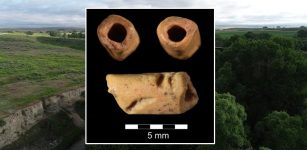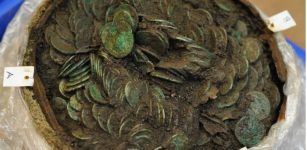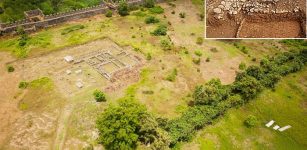Rare 2000-Year-Old Celtic Figurine Among Finds In Cambridgeshire
Conny Waters - AncientPages.com - An extremely rare, 5 cm long copper alloy human figurine, most likely made in the 2nd Century AD has been unearthed in archaeological diggings at the National Trust’s Wimpole Estate in Cambridgeshire, rural settlement on the site which is now home to a working farm and Georgian mansion house.
The artifact is dated to a Late Iron Age to Early Roman (c.100 BC – 150AD).
The 2000 year old figurine discovered during the dig on the Wimpole Estate. National Trust Images/James Fairbairn, Oxford Archaeology East
The faceless individual appears to be holding a ‘torc’, which is a high status Celtic neck ring, and is thought to represent ‘Cernunnos’, the Celtic god of wild things, known throughout the entire Celtic world under different names and under different representations. It is the only metal figurine of this Celtic god known in Britain.
“This is an incredibly exciting discovery, which to me represents more than just the deity, Cernunnos. It almost seems like the enigmatic ‘face’ of the people living in the landscape some 2,000 years ago, " Shannon Hogan, National Trust Archaeologist for the East of England, said in a press release.
“The artefact is Roman in origin but symbolises a Celtic deity and therefore exemplifies the continuation of indigenous religious and cultural symbolism in Romanised societies.”
See also:
Cernunnos ‘Horned One’ – Powerful Continental God Preserved In Celtic Beliefs As Master Of Animals
The settlement is believed to have been at the centre of a strong trading network, with around 300 metal objects uncovered during the dig. The discoveries include coins, cosmetic implements, horse harness fittings, Roman military uniform fittings, a spearhead, an axe head, key handles, brooches, a ring as well as scrap lead and a number of iron nails and other utilitarian objects.
Following an initial geophysical survey in 2016, Oxford Archaeology East undertook a trial trench evaluation to examine the identified ditches and enclosures, which yielded pottery dating to the Late Iron Age-Early Roman period (c. 100BC to 150AD). Subsequently 1.6 hectares was earmarked for full archaeological excavation in 2018.
The finds from Wimpole are being cleaned, catalogued and analysed and will form the basis of future exhibitions at Wimpole.
Written by Conny Waters - AncientPages.com Staff Writer





















